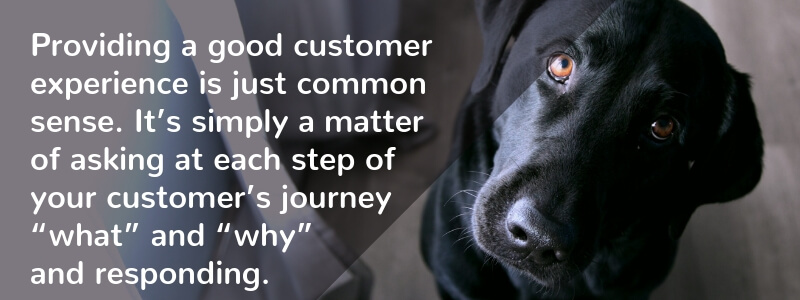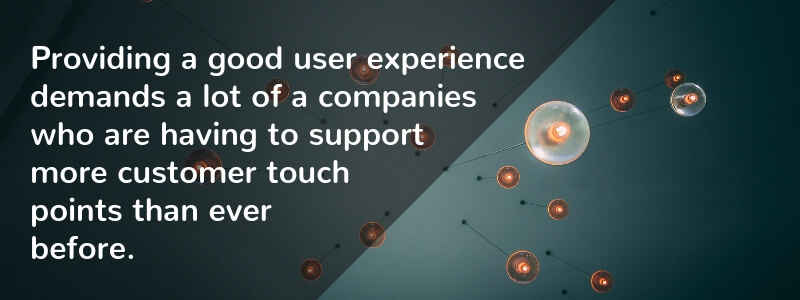Why great UX is hard to do
And how to make it easier

Does it seem like everyone is getting on the UX bandwagon, without really knowing why?
By Martin Stewart : 4th of December 2018
This may sound a little controversial given how much focus is placed on better UX design, but I believe the current enthusiasm is misplaced. Because it seems that with the focus on UX we’re losing our focus on what really matters; user experience.
Wait, what? Aren’t they the same thing? Well yes, technically – but it seems to me that they are framed differently, and the devil is in that detail.
‘UX’ is more often discussed within the context of product design where it is uses digital technology and big data to create value and points of differentiation so that customers will choose Brand X over Brand Y – it’s experience seen through a sales and marketing lens. Rather than marketing products, they now market experiences.
What this version of UX may miss though is the complete end-to-end user experience, especially post sales service. Businesses tend to make the effort to make it easy for clients to buy, but usually neglect the many other aspects of the user experience.
This matters, because if the user does not have a good experience over the longer term they are unlikely to make a repeat purchase, or make positive recommendations to their friends. If you want to form deeper, more long-lasting relationships with customers this broader interpretation of UX is key.

Providing a good customer experience is just common sense. It’s simply a matter of asking at each step of your customer’s journey “what” and “why” and responding. Note that common sense does not mean easy; providing a good user experience is difficult. For example even innovators with plenty of funding and incredible success like Uber can neglect aspects of the complete customer experience.
For example, articles like How to cancel an Uber request: 10 steps (with pictures) suggest that while Uber makes it very easy to book a ride, it’s not so simple to cancel one – even if it would be a better customer experience.
Another big gripe of many people is that when booking Uber you can see all the vehicles that are nearby but not which one will be allocated to your booking, or how many minutes away it is. This can be critical if you’re in a hurry and are considering alternatives.
You can also find examples in insurance. For instance, it is easy to get instant quotes for car insurance but it’s not easy to switch your policy from one car to another. To get the new car covered you need to answer all the policy questions again. Why is it not possible for the insurer to pre-fill the relevant details from the old car’s policy? Solving situations like this require an internal game of Family Feud to try to work out the top 10 things someone will want to do with their policy once they have it – and then delivering.
Even big software companies like IBM struggle to provide good user experiences. They often invite me to webinars by sending an invite out by email. When you click on the invite to register, you are asked to enter all your information again, even though they obviously have most of your information since you’re on their mailing list. Like a paper cut, this is a small but very frustrating experience which would be very simple to solve – especially for a leading IT vendor.
So why is providing a good total user experience so obvious, and yet so hard?

Providing a good user experience demands a lot of a companies who are having to support more customer touchpoints than ever before, and who still have siloed business areas and IT systems.
This means user experience tends to focus on discrete touchpoints, rather than factoring in the customer’s full experience, creating irregular customer experiences. Think back to my Vodafone example. Their marketing team were clearly provided the challenge of growing the user base, so they developed a campaign which was sure to get attention, and drive takeup. And yet, successful as it was, the campaign wasn’t supported by their voice and data network infrastructure. While they eventually ramped up the network, this wasn’t done quickly enough to meet the new demand.

Reinventing processes requires bringing together representatives from all internal teams, feeding them with lots of yummy, valuable customer insights, challenging them to reimagine how things could work – and then implementing it in unison across the entire business, while keeping the existing business-as-usual processing running smoothly.
Sounds hard. No wonder we resort back to simple goals like A/B testing the colour of our website CTA buttons.
So how can we do UX well?
Atlassian is a great example of a vendor providing a great all-round user experience. Not just great products, but also the regular updates, the support available and even their approach to billing and payments is excellent.
The secret to their great UX is not hiring great UX designers – although I am sure they do. According to Alastair Simpson, Design Leader at Atlassian, “Just because you have a UX person on the team doesn’t solve the problems.” Instead, it comes down to joint teams of product managers, developers, support teams and customers that work together to acknowledge the obvious (and less obvious) pain points, and how to solve them.

My recommendation would be to have a really thorough look at the total user experience you provide before you hire the new web designer with UI/UX experience. Your main problems may be in the back office, not in your front end web systems. Winning new customers and then providing poor service will do more damage than good to your profitability and reputation.
